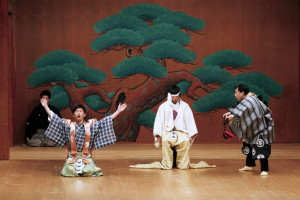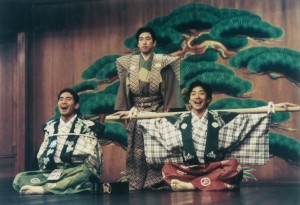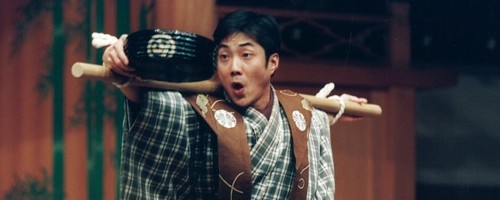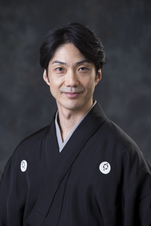Theatre buffs will have plenty more reasons to make the trip up north for the 2014 George Town Festival with legendary thespian Mansai Nomura booked for a double bill at MPPP Town Hall.
The doyen of Japanese performing arts will impart his invaluable knowledge in a collaborative workshop with the Nanning Cantonese Opera Troupe on 22 August before taking to the stage to perform two popular tales from the Mansaku-no-Kai Ky?gen Company repertoire.
In ?The Owl?, a man discovers his brother has been possessed by the spirit of the titular bird after a mysterious trip to the mountains. ?Tied to a Stick? meanwhile recounts the hilarious exploits of a master in his attempt to punish his insubordinate servants. Both best exemplify Ky?gen, a type of medieval Japanese comedy dating back to the 14th century.
Mansai is the latest addition to the Asian Traditional Theatre Series, a month-long celebration of the region?s diverse range of classical dramas. Mansai is one of three big names in the eclectic lineup of acts.
The Joe Louis Traditional Thai Puppet Theatre is the sole authority on the art form invented by Krae Saptawanit in 1901. After a hiatus of some 50 years, Sakorn Yangkhiawsod revived hun lakorn lek (small puppets) in 1995 and ensured its survival by passing down the techniques to his nine children before his death in 2007. The group has since struck gold twice at the World Festival of Puppet Art in Prague.
The Nanning Cantonese Opera Troupe is known for its interpretations of traditional classical Chinese opera, a form which dates back to the third century, and for its performances of new works in the classical style.
Jointly presented by the George Town Festival and Japan Foundation Kuala Lumpur, the project is part of ongoing efforts by the Japan Foundation Asia Center to enhance intercultural exchanges between Southeast Asian countries in the years leading up the 2020 Olympic and Paralympic Games.
Malaysia will be familiar ground to Mansai. In 2012, he weaved his magic in front of a sold-out crowd at the Malaysia Tourism Centre in Kuala Lumpur. He will be joined in Penang this year by a four-member ensemble of rising stars in the Ky?gen scene.
| Date & Time: 22nd August, 7:30pm Venue: MPPP Town Hall (location) Participation: Free Registration: George Town Festival Secretariat TEL: ? 261 6308 ADD: 1st Floor, 86 Lebuh Armenian, George Town. |
Date & Time: 23rd August, 8:30pm ? 9:30pm Venue: MPPP Town Hall (location) Admission: RM 20 – RM 60 Ticket Purchase: 1. www.AirAsiaRedtix.com 2. Rock Corner and Victoria Music outlets 3. Tune Store, Low Yat Plaza |
 The Owl (20 min)
The Owl (20 min)
(梟山伏 FKURO YAMABUSHI)
A man is concerned about his younger brother Taro because he has been acting strangely since returning from an excursion in the mountains two or three days ago. The man visits a friend of his who is a mountain priest to request that he come and offer prayers to cure the unfortunate Taro.
They set out immediately for the man’s home. Upon arrival, the mountain priest performs an extremely exaggerated preparatory ceremony, and then starts the curing incantation. In response to the incantation, Taro begins hooting like an owl. The man explains that when Taro went to the mountain recently, he knocked down an owl’s nest, and the mountain priest immediately senses that the problem is that Taro has been possessed by the spirit of the angry owl.
Mountain Priest | Kazunori Takano
Man | Ren Naito
Taro | Go Iida
 Tied to a Stick (30 min)
Tied to a Stick (30 min)
(棒縛 BO-SHIBARI)
A master is unhappy because his two servants Taro Kaja and Jiro Kaja drink his wine when he is out. He calls Jiro Kaja and discusses the best way to punish Taro Kaja. Jiro Kaja suggests that they have him demonstrate his favorite art of stick fighting and tie him to the stick. Taro Kaja easily falls into the trap and both his hands are tied to both ends of his stick. Jiro Kaja laughs, but the master sneaks up behind him and ties them together. The master explains that he has tied them up to keep them from stealing and drinking his wine while he is out. He then leaves. As soon as he is gone, the two servants find themselves even more thirsty than usual.
Master | Shuichi Nakamura
Taro Kaja | Mansai Nomura
Jiro Kaja | Kazunori Takano
What is Ky?gen?
Along with Noh, Bunraku and Kabuki, Ky?gen is one of the four representative classical theatre arts of Japan. It is a form of medieval popular comedy that arose in the Kyoto area contemporaneously with Noh in the early 14th century. While Noh focuses on meditation and memory, sin and salvation, Kyogen positively affirms human nature with the exquisite usage of humour. Ky?gen has been attracting thousands of audiences, mixed in terms of age, class and gender, since its inception till today. In 2001, Noh and Ky?gen were designated ?the oral and intangible heritage of humanity? by UNESCO. Bunraku and Kabuki followed suit in 2003 and 2005 respectively.
Mansaku-no-Kai Ky?gen Company
The Mansaku-no-Kai Ky?gen Company is a Ky?gen group founded by Mansaku Nomura II and led with his son Mansai II. Both were members of an illustrious theatrical line that boasts a 250-year history. Since the company?s first tour abroad to the Paris International Theatre Festival in 1957, Mansaku has been a pioneer in sharing the art of Ky?gen with international audiences by giving performances and lectures worldwide. In continuing his father’s mission, Mansai not only performs Ky?gen extensively but also commits himself to exploring further possibilities of Ky?gen as a contemporary performing art. Mansaku has been named a Living National Treasure of Japan while three members of Mansaku-no-Kai ? Mannnosuke Nomura, Mansai Nomura and Yukio Ishida ? are designated Holders of Important Intangible Cultural Property in Nohgaku.




